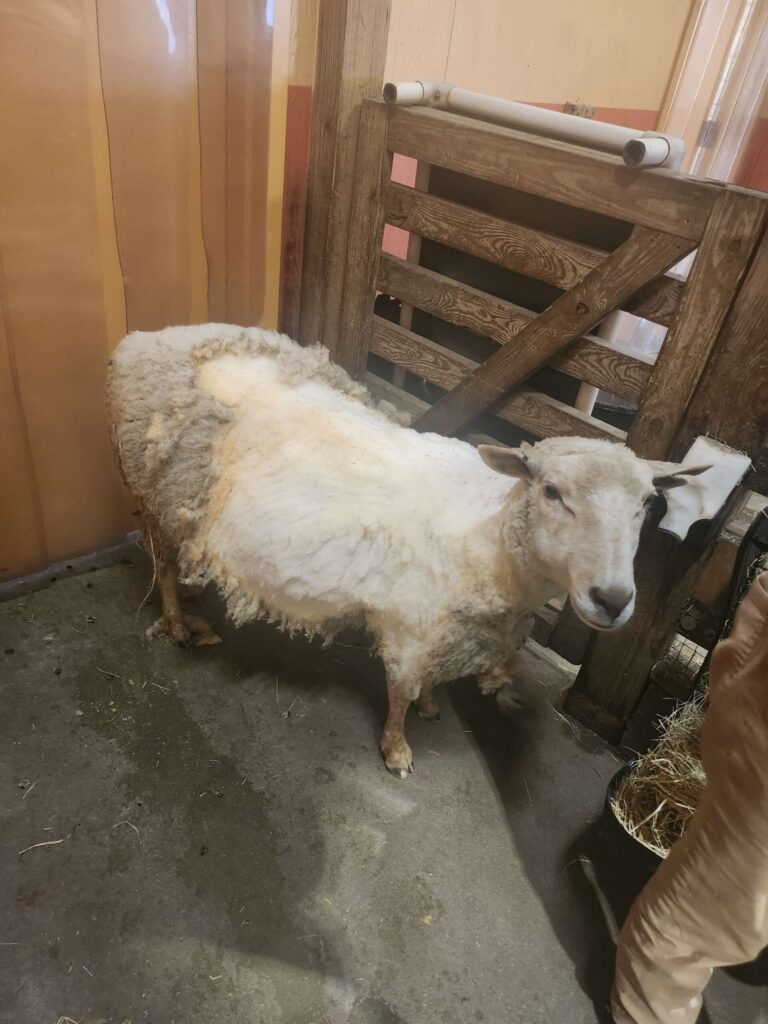Summary of Shearing time at Outback Station:
Christina L., in a post dated April 23, 2024, shared insights from the Outback Station at the zoo, highlighting the onset of spring and its impact on the resident sheep. As temperatures rise, the thick wool grown over winter becomes warm and itchy for the sheep, necessitating shearing to prevent overheating. Unlike their goat companions that naturally shed hair, the sheep require assistance. The Ambassador Animals Team has innovated its approach to shearing by training the sheep to participate calmly in the process, utilizing positive reinforcement and gradual adaptation to the sounds and sensations of the clippers. This method, inspired by practices at the Birmingham Zoo, not only enhances the wellbeing of the sheep by allowing them control over the process but also introduces flexibility in scheduling and handling, showcasing a compassionate and innovative approach to animal care. Visitors to the Outback Station may sometimes witness sheep partially shorn, indicating their active involvement in their grooming.
– The importance of shearing in maintaining sheep health and preventing overheating
– Training techniques used by zookeepers for stress-free shearing
– The role of shearing time at Outback Station in educating the public on animal care and welfare
– The collaboration between zoos to improve animal care practices
– How shearing contributes to wildlife conservation efforts and sustainable practices
Shearing time at Outback Station is critical, ensuring the health and wellbeing of the sheep housed there. Unlike other animals that might naturally shed their fur or feathers to adapt to the warmer seasons, sheep require help from humans to remove their woolly coats. This article dives into the intricacies of shearing at Outback Station, aiming to provide insights into the careful practices developed by zoo professionals. With their thick wool grown throughout the winter, shearing relieves these animals, ensuring they do not overheat as the weather warms.
Training sheep for a stress-free shearing process is a nuanced task that demands patience and understanding from zookeepers. At Outback Station, positive reinforcement training has shown excellent results. This technique involves gradually familiarizing the sheep with the shearing process, from the mere presence of shearing clippers to their sound and, finally, the sensation of them against their skin. This systematic approach allows sheep to stay calm during the shearing process, mitigating stress. This benefits the sheep’s wellbeing and ensures the safety and ease of the shearing team.
The shearing process at Outback Station also plays a significant educational role. Visitors, especially children, have the unique opportunity to observe and understand the intricacies of caring for farm animals. Through demonstrations and informative sessions, zoo visitors understand why shearing is necessary; the training sheep undergo to ensure a stress-free experience, and the importance of animal welfare in zoo settings. This interaction provides a platform for wider discussions on animal care, fostering a deeper appreciation and understanding among visitors for the efforts undertaken by zoos to safeguard the animals in their care.
Collaboration between zoos is essential in improving and evolving animal care practices. The shared experiences and learned strategies, such as those from the Birmingham Zoo mentioned in the initial prompt, enrich the collective knowledge within the zoo community. This collaborative approach enhances welfare standards across zoos globally, ensuring that animals receive the best care possible through shared insights and improvements in handling, training, and shearing techniques.
Lastly, shearing time at Outback Station contributes to broader wildlife conservation efforts and promotes sustainable practices. By engaging the public in these activities and explaining their significance, zoos like Outback Station are pivotal in raising awareness about wildlife conservation. For instance, the wool sheared from the sheep can be utilized in various ways, demonstrating a sustainable cycle that supports conservation messages and practices. This aspect of shearing reinforces the importance of animal care and highlights the zoo’s role in broader environmental stewardship.
Through careful training, public engagement, collaborative efforts, and a focus on sustainability, shearing time at Outback Station embodies the meticulous care and dedication zoos invest in the welfare of their animals. It underscores the multifaceted role zoos play in conservation, education, and the fostering of sustainable practices, engaging a wide audience in the vital conversation about our interaction with the natural world and its creatures.


